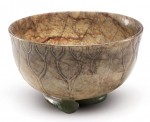Funerary objects of jade
 According to the Historical Records, in 1046 BC the capital city of the Shang was lost to armies of King Wu of the Zhou. Reluctant to be a prisoner of war, King Zhou of the Shang, a most notorious tyrant in Chinese history, set a fire and burned himself to death with a “jade shroud” on. The “shroud”, so to speak, consisted of his most valuable jade pieces strung together, which he wanted to perish together with him.
According to the Historical Records, in 1046 BC the capital city of the Shang was lost to armies of King Wu of the Zhou. Reluctant to be a prisoner of war, King Zhou of the Shang, a most notorious tyrant in Chinese history, set a fire and burned himself to death with a “jade shroud” on. The “shroud”, so to speak, consisted of his most valuable jade pieces strung together, which he wanted to perish together with him.
Far back in prehistory times, it was already believed that jade pieces helped preserve dead bodies. Large quantities of jade artifacts have been excavated from ancient tombs, including even grave clothes made of jade pieces, jade bars in the hands of the dead and jade plugs to gorge the mouth, nose, eyes and ears of the dead with. From tombs of the Liangzhu culture, archeologists have unearthed jade pieces strung together to cover the dead body with. Nearly 100 jade pieces were found on the cover of the coffin when, in 1990, a tomb of the Gao State of the Spring and Autumn period was opened for excavation. The dead body is covered from head to toe with jade pieces. The most remarkable is a piece of textile with small pieces of jade sewn to it, with tiny holes on them to facilitate the sewing.
Things like the “jade veil” and the “jade shroud” that perished along with King Zhou of the Shang were to be developed into “jade grave clothes” – in fact sets of small, polished jade chips sewn together with gold, silver, copper and even silk thread. Two dozen such sets have been unearthed from tombs of princes of the Han Dynasty (206 BC – 220 AD). Each set consists of five “jade cases” separately for the head, the upper part of the body, the lower limbs, the hands and the feet which, put together, assume the shape of a human figure. The jade attire for Prince Liu Sheng of the West Han Dynasty, which was unearthed from his tomb in Mancheng County of Hebei Province, north China, consists of 2,498 jade chips sewn with 1.1 kilograms of gold thread. The prince’s wife shared the tomb with Diflucan Online Pharmacy No Prescription Needed him. She also had jade attire on. Moreover, large quantities of jade ornaments were found in her coffin, the inner walls of the coffin inlaid with as many as 192 jade plates.
After the Han Dynasty, however, use of jade artifacts was no longer limited to aristocrats. It expanded to include rich merchants, landlords and scholars keen to display their social status and wealth. This is due to increased communication between China and areas to its west via the Silk Road, which subsequently boosted the country’s import of raw jade from Central Asia that encompasses what is now Xinjiang Uygur Autonomous Region. As time went by, jade carvings, in fact carvings of not only “soft jade” but also other precious stones like agate and jadeite, became a thriving industry meeting a huge demand from the upper class. Carving techniques and workmanship improved constantly, especially during the period from the Tang Dynasty to the Song and the period when China was under two successive dynasties, the Ming and Qing. People seem to forget that once upon a time, in China’s slavery society, use of jade artifacts was a part of the social estate system prevalent at the time. As ornaments, however, jade artifacts will remain an important aesthetic choice for the Chinese people.